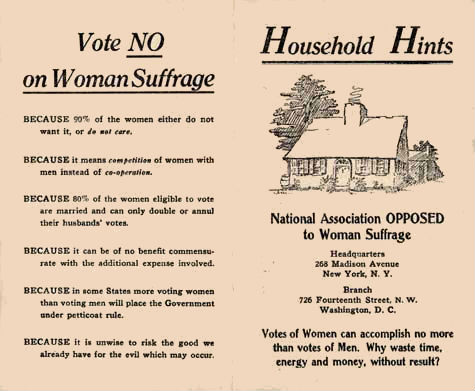Learning from Fallacy
By Peter LloydCreativity demands freedom—freedom of expression, speech, assembly, association, and behavior that all consenting parties find mutually satisfying or at least tolerable. Our creative freedom depends on the tolerance of others. So we have to defend it from intolerance.
The intolerant among us have always argued and continue to argue for repression. When you hear arguments for intolerance today, the political noise carrying those arguments tends to obscure their fallacy. It’s much easier to recognize fallacy in debates of the past concerning issues now considered settled.
 Go back and examine, for example, the cases for slavery or Prohibition. It should be blindingly clear how wrong they were and are.
Go back and examine, for example, the cases for slavery or Prohibition. It should be blindingly clear how wrong they were and are.I just happen to have come across a printed piece arguing against women’s suffrage. The headline (bottom right) attempts to summarize a list of six arguments.
Votes of Women can accomplish no more than votes of Men. Why waste time, energy and money, without result?Let’s look at each of the six anti-suffrage arguments on the left half of the piece and identify what makes them fallacious in the hopes of helping us recognize similarly false justifications for contemporary attacks on other creative, social, and political freedoms.
BECAUSE 90% of the women do not want it, or do not care.
They say 67 percent of statistics are concocted on the spot. But let’s assume someone actually interviewed enough women to justify this claim. It means nothing. As Steve Jobs sagaciously concluded, “People don’t know what they want until you show it to them.” A healthy 46.2 percent of women voted in the US 2010 national election.
But the claim that women did not want to vote is meaningless as an argument because allowing women to vote does not force even one of them to do so.
I’m intrigued also by the phrase the women. It’s akin to the Ukraine. A way to diminish the status of both.
BECAUSE it means competition of women with men instead of co-operation.
Now let’s parse words. The kind of cooperation the authors were talking about was obviously more like obedience. No doubt the folks who wanted to eliminate so-called competition from women also advocated free competition in the marketplace for themselves.
BECAUSE 80% of the women eligible to vote are married and can only double or annul their husbands’ votes.
And the point is? Doubling or annulling the votes of other citizens is what voting and democracy are all about. We have a circular argument here. Strip it down to its essential meaning and it bares its vacuity: letting women vote will allow women to vote.
In this specious argument we also see what we have since rejected as the old barnyard definition of marriage—men must rule the roost. Just like the ideas of communication, media, art, education, and family, the idea of marriage will continue to evolve. Calling up old definitions is the last resort of tired, conservative advocacy.
BECAUSE it can be of no benefit commensurate with the additional expense involved.
Not much of an argument here. We see it today in the ridiculous assumption that progress needs to be cost-free. Its flip side is just as ludicrous. Namely that anything that makes money must be good. If that were true, then outlawing hired assassination would be wrong for all the hit men it will put out of work.
If it’s right, we should do it, then find ways to pay for it. If it’s wrong, like slavery, we should stop doing it, even if it comes with a financial burden.
BECAUSE in some States more voting women than voting men will place the Government under petticoat rule.
Give a good idea a scary-sounding name and you can frighten the unenlightened. This Frank Luntz-like abuse of language is nothing new. The phrase petticoat rule was meant to terrify then, just like death tax terrifies or enhanced interrogation mollifies today.
Let’s not overlook the old illusory superiority bias in this rationale—the fallacious overvaluation of one’s own attributes and affiliations with respect to those of others.
BECAUSE it is unwise to risk the good we already have for the evil which may come.
This, the oldest of conservative saws—stay the course—is just plain lame. Even when stay the course is the correct choice, it should stand on its merits, not merely on its existence.
The old adage, “Better the devil you know than the devil you don’t,” would have prevented the American Revolution that set the stage for all the freedoms that preceded and were to follow women’s suffrage.
Everything free people cherish has come from the extension rather than the limitation of rights. Creativity, invention, innovation, scientific investigation, and artistic expression all depend on my and your freedom to explore and express ourselves.
It’s up to all of us, then, to arm ourselves with the arguments to defend creative freedom.
Peter Lloyd is co-creator with Stephen Grossman of Animal Crackers, the breakthrough problem-solving tool designed to crack your toughest problems.
Right Brain Workouts Explained
